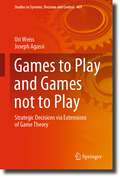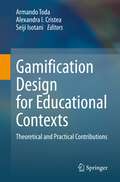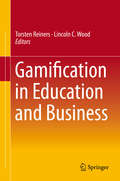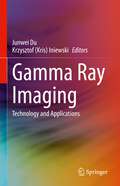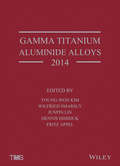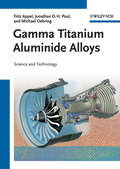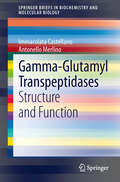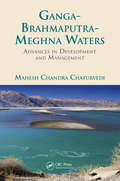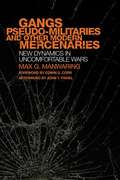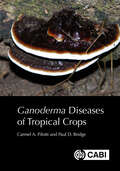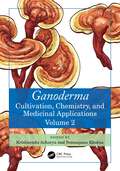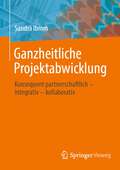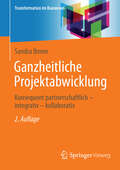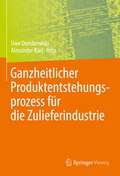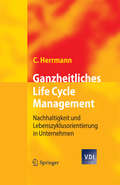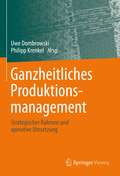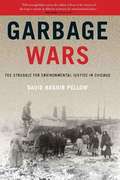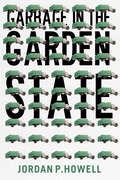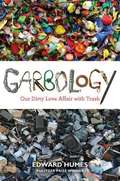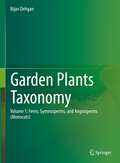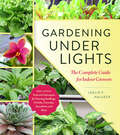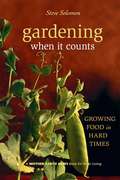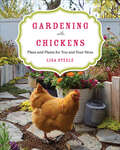- Table View
- List View
Games to Play and Games not to Play: Strategic Decisions via Extensions of Game Theory (Studies in Systems, Decision and Control #469)
by Joseph Agassi Uri WeissThis book contributes to the theoretical discussions of equilibria that rest on error―in which we include mistaken choices of games to play. Extant game theory recommends diverse strategies (plans of actions) for various given games, particularly those in Nash equilibria, in which no player benefits from one-sided strategy alteration. The literature also refers to the design of games that fit given goals. This is the mechanism design theory; its function is to serve social planners ignorant of the preferences of the people intended to play them.Our study of games avoidance adds to game theory the meta-game of choosing what game to play and what game to avoid playing, and that both players and planners can generate. This comprises a shift from the maximalist position that aims to maximize possible profit to the minimalist one that aims at minimizing possible loss. This shift depends on the question, considering the public interest, what set of games is it advisable to encourage? Obviously, it is advisable to encourage playing some groups of games such as trade, as well as to discourage playing other groups of games such as wars. This shift makes the theory much more applicable to social science: usually, choosing what game to play is less practical than choosing what game not to play. This invites legislation and similar incentives; their study should aim at the improvement of their usefulness.Discussing the possibility of changing both game and strategy renders game theory part-and-parcel of social science. For this mathematical models will not do: it requires a clear distinction between describing options and explaining situations. Explanations may enhance efforts at improvement.
Gamification Design for Educational Contexts: Theoretical and Practical Contributions
by Alexandra I. Cristea Seiji Isotani Armando TodaHave you ever wondered how to best add game-like elements to your (online) courses? What makes some game features desirable, and others boring? This book covers gamification design in educational domains. It is aimed at practitioners, researchers and academics alike. Gamification design is a recent and relevant topic in many domains; however, it is not well explored in the domain of education, with only a few frameworks available and most of these being only academic (e.g., theoretical) and not addressing practical issues related to education practitioners (e.g., teachers and instructors). The book is divided into 3 parts, in part 1 we explain some basic concepts related to gamification and gamification design, its importance for the education domain, possible negative effects if gamification design is neglected, and aspects that are still not encompassed by this field. Following, part 2 focus on explaining data-driven gamification design concepts as well as a research framework on how to use data mining algorithms to analyze and interpret data to generate strategies that can be used in education domain. It also presents a conceptual framework on how to apply those strategies in the education domain, focusing on the teacher and instructor; Finally, part 3 presents discussions regarding the concepts covered in the book, as well as possible research directions
Gamification in Education and Business
by Torsten Reiners Lincoln C. WoodThis book is dedicated to applied gamification in the areas of education and business, while also covering pitfalls to avoid and guidelines needed to successfully implement for a project. Using different theoretical backgrounds from various areas including behavioral economics, game theory, and complex adaptive systems, the contributors aim to help readers avoid common problems and difficulties that they could face with poor implementation. The book's contributors are scholars and academics from the many areas where the key theory of gamification typically comes from. Ultimately, the book's goal is to help bring together the theories from these different disciplines to the field of practice in education and business. The book is divided into four parts: Theory, Education, Business, and Use Cases. Part I provides a foundation on the theory of gamification and offers insight into some of the outstanding questions that have yet to be addressed. In Part II, the application and value that gamification can bring within the education sector is examined. The book then changes focus in Part III to spotlight the use of gamification within business environments. The topics also cover educational aspects like improved learning outcomes, motivation, and learning retention at the workplace. Finally Part IV concentrates on the applications and use of gamification through a series of case studies and key elements that are used in real situations to drive real results.
Gamma Ray Imaging: Technology and Applications
by Krzysztof Kris Iniewski Junwei DuThis book will provide readers with a good overview of some of the most recent advances in the field of detector technology for gamma-ray imaging, especially as it pertains to new applications. There will be a good mixture of general chapters in both technology and applications in medical imaging and industrial testing. The book will have an in-depth review of the research topics from world-leading specialists in the field. The conversion of the gamma-ray signal into analog/digital value will be covered in some chapters. Some would also provide a review of CMOS chips for gamma-ray image sensors.
Gamma Titanium Aluminide Alloys 2014
by Dennis Dimiduk Fritz Appel Junpin Lin Young-Won Kim Wilfried SmarslyThis book is a collection of papers presented at the 4th International Symposium on Gamma TiAl Alloys (ISGTA 2014) that was held in conjunction with the 2014 Annual Meeting of The Minerals, Metals & Materials Society. Papers discuss and assess advances in application and implementation experience in current alloys, fundamentalaspects in current gamma alloy materials technology, new processes development and assessment, and emerging new alloys, their potentials and limitations, and breakthroughs. Papers that originated in the panel discussion of the symposium are intended to help the scientific community realize the limitations of current alloys materials and processes and discuss possible solutions. Six topic areas selected for this purpose included: Wrought-processed alloys: status, dilemmas and pathways to futureCast alloys for aero engine applications: status, issues, and barriers to advancesCast alloys for turbocharger wheels: status and barriers to widespread applicationsEmerging new alloys: justification, potentials, status, and futureNovel processes: justification, potential vs. realization issues, and futureFuture applications and realistic pathways to them
Gamma Titanium Aluminide Alloys: Science and Technology
by Jonathan David Paul Michael Oehring Fritz AppelThe first book entirely dedicated to the topic emphasizes the relation between basic research and actual processing technologies. As such, it covers complex microstructures down to the nanometer scale, structure/property relationships and potential applications in key industries. From the contents: * Constitution * Thermophysical Constants * Phase Transformations and Microstructures * Deformation Behaviour * Strengthening Mechanisms * Creep * Fracture Behaviour * Fatigue * Oxidation Resistance and Related Issues * Alloy Design * Ingot Production and Component Casting * Powder Metallurgy * Wrought Processing * Joining * Surface Hardening * Applications and Component Assessment
Gamma-Glutamyl Transpeptidases: Structure and Function
by Immacolata Castellano Antonello MerlinoGamma-Glutamyl Transpeptidases (γ-GTs) are members of the N-terminal nucleophile hydrolase superfamily, enzymes that cleave the γ-glutamyl amide bond of glutathione to liberate cysteinylglycine. The released γ-glutamyl group can be transferred to water (hydrolysis) or to amino acids or short peptides (transpeptidation). γ-GT plays a key role in the gamma glutamyl cycle by regulating the cellular levels of the antioxidant glutathione, hence it is a critical enzyme in maintaining cellular redox homeostasis.γ-GT is upregulated during inflammation and in several human tumors, and it is involved in many physiological disorders related to oxidative stress, such as Parkinson's disease and diabetes. Furthermore, this enzyme is used as a marker of liver disease and cancer. This book covers current knowledge about the structure-function relationship of γ-GTs and gives information about applications of γ-GTs in different fields ranging from clinical biochemistry to biotechnology and biomedicine.
Gandhi's Printing Press
by Isabel HofmeyrAt the same time that Gandhi, as a young lawyer in South Africa, began fashioning the tenets of his political philosophy, he was absorbed by a seemingly unrelated enterprise: creating a newspaper. Gandhiâe(tm)s Printing Press is an account of how this project, an apparent footnote to a titanic career, shaped the man who would become the world-changing Mahatma. Pioneering publisher, experimental editor, ethical anthologistâe"these roles reveal a Gandhi developing the qualities and talents that would later define him. Isabel Hofmeyr presents a detailed study of Gandhiâe(tm)s work in South Africa (1893âe"1914), when he was the some-time proprietor of a printing press and launched the periodical Indian Opinion. The skills Gandhi honed as a newspapermanâe"distilling stories from numerous sources, circumventing shortages of typeâe"influenced his spare prose style. Operating out of the colonized Indian Ocean world, Gandhi saw firsthand how a global empire depended on the rapid transmission of information over vast distances. He sensed that communication in an industrialized age was becoming calibrated to technological tempos. But he responded by slowing the pace, experimenting with modes of reading and writing focused on bodily, not mechanical, rhythms. Favoring the use of hand-operated presses, he produced a newspaper to contemplate rather than scan, one more likely to excerpt Thoreau than feature easily glossed headlines. Gandhiâe(tm)s Printing Press illuminates how the concentration and self-discipline inculcated by slow reading, imbuing the self with knowledge and ethical values, evolved into satyagraha, truth-force, the cornerstone of Gandhiâe(tm)s revolutionary idea of nonviolent resistance.
Ganga-Brahmaputra-Meghna Waters: Advances in Development and Management
by Mahesh Chandra ChaturvediOnce a prosperous region, the Ganga-Brahmaputra-Meghna (GBM) river basin-inhabited by about a tenth of the world's population-is currently one of the poorest. Large-scale socioeconomic development is urgently needed to ensure the sustainability of the region, and the management of water resources is a crucial part of this. Ganga-Brahmaputra-Meghna
Gangs, Pseudo-Militaries, and Other Modern Mercenaries: New Dynamics in Uncomfortable Wars (International and Security Affairs Series #6)
by Max G. Manwaring Edwin G. Corr John T. Fishel<p>As the first decade of the twenty-first century has made brutally clear, the very definitions of war and the enemy have changed almost beyond recognition. Threats to security are now as likely to come from armed propagandists, popular militias, or mercenary organizations as they are from conventional armies backed by nation-states. In this timely book, national security expert Max G. Manwaring explores a little-understood actor on the stage of irregular warfare—the gang. <p>Since the end of the Cold War, some one hundred insurgencies or irregular wars have erupted throughout the world. Gangs have figured prominently in more than half of those conflicts, yet these and other nonstate actors have received little focused attention from scholars or analysts. This book fills that void. <p>Employing a case study approach, and believing that shadows from the past often portend the future, Manwaring begins with a careful consideration of the writings of V. I. Lenin. He then scrutinizes the Piqueteros in Argentina, gangs in Colombia, private armies in Mexico, Hugo Chavez's use of popular militias in Venezuela, and the looming threat of Al Qaeda in Western Europe. <p>As conventional warfare is increasingly eclipsed by these irregular and “uncomfortable” wars, Manwaring boldly diagnoses the problem and recommends solutions that policymakers should heed.</p>
Ganoderma Diseases of Tropical Crops
by Paul Bridge Dr Carmel A PilottiThe fungal genus Ganoderma includes around 80 currently recognized species that are widely distributed in temperate, subtropical and tropical regions, and cause disease in a range of economically important perennial crops and tree-like plants. Ganoderma root and lower stem rots have a significant impact on yields from crops including oil palm, coconut, beverage crops, Acacia and rubber. The identification of species responsible for stem and butt rots is often ambiguous as closely related species may only be distinguished by subtle morphological differences. Within species there can be considerable morphological plasticity and this can make morphology-based identification difficult, particularly for species described from a single specimen. Molecular techniques are helping to slowly resolve Ganoderma taxonomy but it will be some time (if ever) before the taxonomy is fully resolved. This book brings together information on Ganoderma species that are reported to be responsible for crop diseases in tropical and sub-tropical agriculture and covers taxonomy, biology, genetics, aetiology, epidemiology and control. This book is an essential resource for researchers in Ganoderma in crop science and tropical agriculture, as well as practitioners and industry.
Ganoderma: Cultivation, Chemistry, and Medicinal Applications, Volume 2
by Krishnendu Acharya Somanjana KhatuaFor the past two millennia, Ganoderma has been prized as the "mushroom of immortality" in ancient Asian cultures, owing to its health benefits. Modern research has further revealed that the genus is rich in bioactive components, including polysaccharides and triterpenoids, uncovering various medicinal prospects both in vitro and in vivo. Clinical trials conducted so far have emphasized the safe and effective use of the mushrooms, with a particular focus on Ganoderma lucidum. Currently, the Ganoderma-based industry is witnessing a significant surge, offering a plethora of dietary and medicinal products. Recognizing the impact of these developments, the book Ganoderma: Cultivation, Chemistry, and Medicinal Applications Volume 2 aims to consolidate the latest information on the macrofungi, emphasizing its bioactive compounds, diverse therapeutic effects, and industrial applications.Key Features: This book provides a thorough exploration of Ganoderma polysaccharides, unraveling their chemical composition, structure, and potential health benefits. Comprehensive coverage is provided to understand antimicrobial properties of the medicinal mushrooms. The text also delves into the potential role of Ganoderma in safeguarding against various skin diseases, accompanied by discussions on underlying mechanisms. A detailed examination of Ganoderma includes its potential cardioprotective effects, encompassing impacts on blood pressure, cholesterol level, and overall heart function. This book also provides an in-depth analysis of the capacity of the macrofungi to stimulate the immune system. The volume encompasses findings related to the impact of Ganoderma on prevention or mitigation of neurodegenerative diseases. Additionally, it contributes to the understanding of medicinal applications by exploring Ganoderma-based nanoparticles, offering novel insights into potential therapeutic avenues. A comprehensive overview of the Ganoderma-inspired industry highlights its diverse contributions ranging from dietary supplements, cosmeceuticals, and nutricosmetics to healthcare products.
Ganzheitliche Gestaltung mobiler Arbeit (ifaa-Edition)
by ifaa – Institut für angewandte Arbeitswissenschaft e. V.Das zunehmende Interesse an mobiler Arbeit sowohl bei Unternehmen als auch bei Beschäftigten führt auf betrieblicher Ebene zu Gestaltungsherausforderungen. Aufgrund des heterogenen Verständnisses von mobiler Arbeit und den unterschiedlichen Motivationen der Beteiligten erscheint "die eine beste Lösung" zur Einführung von mobiler Arbeit im Betrieb nicht realistisch. Bereits gemachte Praxiserfahrungen untermauern diese These. Es existieren zwar vielfältige Unterstützungstools, die auch genutzt werden (können), diese Checklisten, Handlungshilfen etc. adressieren in der Regel aber nur ein relevantes Thema von vielen, bei der Einführung von mobiler Arbeit, die es zu bewältigen gilt. Vor diesem Hintergrund hat das ifaa – Institut für angewandte Arbeitswissenschaft e. V. ein Rahmenkonzept entwickelt, das die ganzheitliche Gestaltung und Einführung mobiler Arbeit in den Blick nimmt und die Betriebe bei der Einführung mobiler Arbeit unterstützt.
Ganzheitliche Projektabwicklung: Konsequent partnerschaftlich - integrativ - kollaborativ
by Sandra IbromGanzheitliche Projektabwicklung ist eine grundlegend neue Philosophie und Herangehensweise wie Baurojekte jeder Größenordnung menschlich und daher auch wirtschaftlich erfolgreich abgewickelt werden können. Dabei wird aktuelles Management-, Führungs- sowie Kommunikationswissen zusammengeführt und durch radikal vereinfachte und kooperationsfreundliche Vertragsgestaltungen rechtlich gestützt. Sie ist die Grundlage einer neuen Kultur in der Projektabwicklung. Durch den umfassenden mediativen Ansatz wird der notwendige Umkehrprozess ermöglicht, weg von dem bisherigen Gegeneinander und hin zu einer für alle Beteiligten und Betroffenen gewinnbringenden Zusammenarbeit. So macht Arbeiten in Bauprojekten wieder Spaß und ermöglicht nachhaltige Wertschöpfung im und durch das Projekt.
Ganzheitliche Projektabwicklung: Konsequent partnerschaftlich - integrativ - kollaborativ (Transformation im Bauwesen)
by Sandra IbromGanzheitliche Projektabwicklung ist eine grundlegend neue Philosophie und Herangehensweise wie Baurojekte jeder Größenordnung menschlich und daher auch wirtschaftlich erfolgreich abgewickelt werden können. Dabei wird aktuelles Management-, Führungs- sowie Kommunikationswissen zusammengeführt und durch radikal vereinfachte und kooperationsfreundliche Vertragsgestaltungen und Ausschreibungen rechtlich gestützt. Sie ist die Grundlage einer neuen Kultur in der Projektabwicklung. Durch den umfassenden mediativen Ansatz wird der notwendige Transformationsprozess ermöglicht, weg von dem bisherigen Gegeneinander und hin zu einer für alle Beteiligten und Betroffenen gewinnbringenden Zusammenarbeit. So macht Arbeiten in Bauprojekten wieder Spaß und ermöglicht nachhaltige Wertschöpfung im und durch das Projekt
Ganzheitlicher Produktentstehungsprozess für die Zulieferindustrie
by Uwe Dombrowski Alexander KarlDer Produktentstehungsprozess erfordert auch von kleinen und mittleren Lieferanten zunehmend eine übergreifende Koordination. Dies resultiert zum einen aus den steigenden Anforderungen an den Produktentstehungsprozess, zum anderen verlagern Unternehmen einen wachsenden Anteil ihrer Entwicklungsleistung auf Lieferanten. Um signifikante Verbesserungen im Bereich der Entwicklungszeit, -kosten sowie -qualität zu erzielen, ist eine systematische Integration der Lieferanten notwendig. Zur Steigerung der Effektivität und Effizienz ist es erforderlich, dass alle Partner innerhalb des Wertschöpfungsnetzwerks nach gleichen Prinzipien und Methoden arbeiten. Bestehende Lean Development-Ansätze der Hersteller müssen auf Lieferanten übertragen, angepasst und deren Schnittstellen zwischen Hersteller und Lieferanten ausgestaltet werden. Das Buch liefert strukturiert und übersichtlich wichtige Grundlagen und studiengestützte Informationen zur Optimierung dieser Zusammenarbeit.
Ganzheitliches Life Cycle Management
by Christoph HerrmannWenn Unternehmen die Anforderungen einer nachhaltigen Entwicklung umsetzen, stehen sie vor der zentralen Aufgabe, Produkte und Prozesse lebensphasenübergreifend zu betrachten. Der Autor stellt die Gestaltungsmöglichkeiten des Life Cycle Managements vor und unterscheidet zwischen lebensphasenbezogenen Disziplinen wie z. B. dem Produkt- und Produktions-Management sowie lebensphasenübergreifenden Disziplinen (z. B. Informations- und Wissensmanagement). Zahlreiche Anwendungsbeispiele und Abbildungen dienen der Veranschaulichung der Inhalte.
Ganzheitliches Produktionsmanagement: Strategischer Rahmen und operative Umsetzung
by Uwe Dombrowski Philipp KrenkelDie Produktion stellt einen entscheidenden Wettbewerbsfaktor zur Herstellung diversifizierter, kundenindividueller Produkte dar. Wesentlich sind die Kundenorientierung, die Vermeidung von Verschwendung und die kontinuierliche Verbesserung der Produktionsprozesse. Hierfür ist eine ganzheitliche Betrachtung des Produktionsmanagements notwendig, wobei es vielzählige Handlungsfelder zu berücksichtigen gilt. In diesem Fachbuch werden diese Handlungsfelder des Produktionsmanagements praxisgerecht und methodisch-strukturiert beschrieben. Ausgehend von der Ausarbeitung einer Produktionsstrategie erfolgt die Beschreibung der Umsetzung und Verbesserung des operativen Produktionsmanagements. Detailliert wird auf die elementaren Grundlagen wie Technologiemanagement, Lean Production, Supply Chain Management, Facility Management, Human Resource Management und weiteres eingegangen. Da sich die Produktionsmethoden und -verfahren in den vergangenen Jahren maßgeblich verändert haben, erhält der Leser darüber hinaus fundiert beschriebene Einblicke in aktuelle Weiterentwicklungen des Produktionsmanagements. Eine besondere Rolle nehmen hierbei Informations- und Kommunikationstechnologien bzw. die Industrie 4.0 ein.
Garbage Wars: The Struggle For Environmental Justice In Chicago (Urban And Industrial Environments Ser.)
by David PellowIn Garbage Wars, the sociologist David Pellow describes the politics of garbage in Chicago. He shows how garbage affects residents in vulnerable communities and poses health risks to those who dispose of it. He follows the trash, the pollution, the hazards, and the people who encountered them in the period 1880-2000. What unfolds is a tug of war among social movements, government, and industry over how we manage our waste, who benefits, and who pays the costs. Studies demonstrate that minority and low-income communities bear a disproportionate burden of environmental hazards. Pellow analyzes how and why environmental inequalities are created. He also explains how class and racial politics have influenced the waste industry throughout the history of Chicago and the United States. After examining the roles of social movements and workers in defining, resisting, and shaping garbage disposal in the United States, he concludes that some environmental groups and people of color have actually contributed to environmental inequality. By highlighting conflicts over waste dumping, incineration, landfills, and recycling, Pellow provides a historical view of the garbage industry throughout the life cycle of waste. Although his focus is on Chicago, he places the trends and conflicts in a broader context, describing how communities throughout the United States have resisted the waste industry's efforts to locate hazardous facilities in their backyards. The book closes with suggestions for how communities can work more effectively for environmental justice and safe, sustainable waste management.
Garbage in the Garden State (CERES: Rutgers Studies in History)
by Jordan P. HowellGarbage in the Garden State is the only book to examine the history of waste management in New Jersey. The state has played a pioneering role in the overall trajectory of waste management in the US. Howell's book is unique in the way that it places the contemporary challenges of waste management into their proper historical context – for instance, why does the system for recycling seem to work so poorly? Why do we have so many landfills in New Jersey, but also simultaneously not enough landfills or incinerators? Howell acknowledges that New Jersey is sometimes imagined, particularly by non-New Jerseyans, as a giant garbage dump for New York and Philadelphia. But every place has had to struggle with the challenges of waste management. New Jersey's trash history is in fact more interesting and more important than most. New Jersey’s waste history includes intensive planning, deep-seated political conflict, organized crime, and literally every level of state and federal judiciary. It is a colorful history, to say the least, and one that includes a number of firsts with regard to recycling, comprehensive planning, and the challenging economics of trash.
Garbology: Our Dirty Love Affair with Trash
by Edward HumesA Pulitzer Prize-winning journalist takes readers on a surprising tour of America's biggest export, our most prodigious product, and our greatest legacy: our trash <P><P> The average American produces 102 tons of garbage across a lifetime and $50 billion in squandered riches are rolled to the curb each year. But our bins are just the starting point for a strange, impressive, mysterious, and costly journey that may also represent the greatest untapped opportunity of the century. <P> In Garbology, Edward Humes investigates trash--what's in it; how much we pay for it; how we manage to create so much of it; and how some families, communities, and even nations are finding a way back from waste to discover a new kind of prosperity. Along the way , he introduces a collection of garbage denizens unlike anyone you've ever met: the trash-tracking detectives of MIT, the bulldozer-driving sanitation workers building Los Angeles' Garbage Mountain landfill, the artists residing in San Francisco's dump, and the family whose annual trash output fills not a dumpster or a trash can, but a single mason jar.<P> Garbology reveals not just what we throw away, but who we are and where our society is headed. Waste is the one environmental and economic harm that ordinary working Americans have the power to change--and prosper in the process.<P> Garbology is raising awareness of trash consumption and is sparking community-wide action through One City One Book programs around the country.<P> It is becoming an increasingly popular addition to high school and college syllabi and is being adopted by many colleges and universities for First Year Experience programs.
Garden Plants Taxonomy: Volume 1: Ferns, Gymnosperms, and Angiosperms (Monocots)
by Bijan DehganHorticulture has remained far behind in understanding of botanical principles. Recent phylogenetic (DNA-based) reorganization of higher plants has revolutionized taxonomic treatments of all biological entities, even when morphology does not completely agree with their organization. This book is an example of applying principals of botanical phylogenetic taxonomy to assemble genera, species, and cultivars of 200 vascular plant families of ferns, gymnosperms, and angiosperms that are cultivated for enhancement of human living space; homes, gardens, and parks. The emphases are on cultivated species but examples of some plants are often shown in the wild and in landscapes. In providing descriptions, it is assumed that students and other interested individuals have no background in general botany (plant characteristics), or nomenclature. Fundamental features of all plant groups discussed are fully illustrated by original watercolor drawings or photographs. Discussion of the families is grounded on recent botanical phylogenetic treatments, which is based on common ancestry (monophyly). Of course, phylogenetic taxonomy is not a new concept, and was originally based on morphological characteristics; it is the DNA-based phylogeny that has revolutionized modern biological classifications. In practical terms, this book represents the horticultural treatment that corresponds to phylogenetic-based botanical taxonomy, to which is added cultigens and cultivated genera and species. Hence, the harmony between horticultural and botanical taxonomy. This book covers phylogenetic-based taxonomy of Ferns, Gymnosperms, and Angiosperms (Monocots). A companion volume covers Angiosperms (Eudicots).
Gardening Under Lights: The Complete Guide for Indoor Growers
by Leslie F. Halleck“If you want to grow plants indoors, you need this book.” —Niki Jabbour, author and staff writer at savvygardening.comGardening Under Lights is a highly-detailed, accessible guide for seed starters, plant collectors, houseplant fans, and anyone who wants to successfully garden indoors any time of the year. You’ll learn the basics of photosynthesis, the science of light, how to accurately measure how much light a plant needs, and details about the most up-to-date tools and gear available. Also included are tips and techniques for helping ornamental plants (like orchids, succulents, bonsai, and more) and edible plants (arugula, cannabis, oregano, tomatoes, and more) thrive indoors. Whether you are a vegetable gardener who wants to extend the growing season, a balcony gardener short on outdoor space, or a specialty plant collector, Gardening Under Lights is a must-have.
Gardening When It Counts: Growing Food in Hard Times (Mother Earth News Books for Wiser Living #5)
by Steve SolomonThe decline of cheap oil is inspiring increasing numbers of North Americans to achieve some measure of backyard food self-sufficiency. In hard times, the family can be greatly helped by growing a highly productive food garden, requiring little cash outlay or watering. Currently popular intensive vegetable gardening methods are largely inappropriate to this new circumstance. Crowded raised beds require high inputs of water, fertility and organic matter, and demand large amounts of human time and effort. But, except for labor, these inputs depend on the price of oil. Prior to the 1970s, North American home food growing used more land with less labor, with wider plant spacing, with less or no irrigation, and all done with sharp hand tools. But these sustainable systems have been largely forgotten. Gardening When It Counts helps readers rediscover traditional low-input gardening methods to produce healthy food. Designed for readers with no experience and applicable to most areas in the English-speaking world except the tropics and hot deserts, this book shows that any family with access to 3-5,000 sq. ft. of garden land can halve their food costs using a growing system requiring just the odd bucketful of household waste water, perhaps two hundred dollars worth of hand tools, and about the same amount spent on supplies -- working an average of two hours a day during the growing season.
Gardening with Chickens: Plans and Plants for You and Your Hens
by Lisa Steele“Beautifully photographed and filled with eye-catching illustrations” this guide to raising chickens alongside vegetables “will become an instant classic” (Niki Jabbour, author of Groundbreaking Food Gardens and The Year Round Vegetable Gardener).Welcome to a world where chickens and gardens coexist! Join Lisa Steele, chicken-keeper extraordinaire and founder of Fresh Eggs Daily, on a unique journey through the garden. Start by planning your garden and learning strategies and tips for keeping your plants safe while they grow. Plant with purpose, choosing from a dozen plans for theme gardens such as Orange Egg Yolks or Nesting Box Herbs. Or choose a design that’s filled with edibles—sharing the bounty with your family and your feathered friends. Then comes the fun part: enjoy the harvest, even let the chickens graze! Lisa’s friendly writing, together with inspirational photos and illustrations, will have you rolling up your sleeves and reaching for your gardening tools. Lisa also covers a range of topics about chicken-keeping, including:- Chickens and composting- Using chickens to aerate and till- Coop window boxes- Plants to avoid when you have chickens- Lists of the most valuable crops and herbs- Advice on how to harvest and use many of the plants- And much more!Whether you’re an experienced chicken keeper, master gardener, or just getting into these two wonderful hobbies, Gardening with Chickens is an indispensable guide for a harmonious homestead.“Can a garden—especially a tempting vegetable garden—peacefully coexist with hungry, inquisitive chickens?. . . . It’s a smart subject for a book, and the answer, says Gardening With Chickens author Lisa Steele, is that they can not only coexist, but each can benefit the other.” —GardenSmartTV
